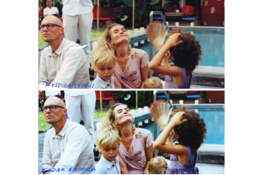That's pretty much literally what they call it. I've noticed they distinguish consumer and professional emulsions. It's not entirely clear to me where the divide is, but apparently, Plain CA and CA Supreme are consumer grade, while CA Supreme
HD, DPII, Velvet and Maxima are pro-grade emulsions. The main difference between the papers is the thickness of image-forming layers (color density/chroma), interlayers (crossover and thus chroma/saturation) and topcoat (physical and UV protection).
What I know about this comes straight from Fuji engineers. I summarized what I know about the digital/optical thing here:
https://tinker.koraks.nl/photograph...a4-paper-is-digital-and-why-this-matters-not/
I specifically had a Fuji engineer (working on color papers for 35+ years) verify what I wrote down and in particular the plot I included, and his response was that the essence of the article is spot on. There are some details that I may not have captured well; I expect e.g. the toe- and shoulder-areas of the curves, the exact gamma of each layer etc. They won't precisely fit the Fuji data. The plot where you see the green curve deviate strongly from the red and blue ones is one I recreated from memory after having been shown that plot by the same engineer, straight from their QA database. These are the kinds of plots they make to verify that manufactured paper performs to specification, so it's readily available data within the plant in question.
I also specifically asked him several times if it's correct that optical enlargement will result in color crossovers with today's digital papers. This was very explicitly confirmed. We also discussed the potential of using LED exposure for optical enlargement and agreed that this in itself does not fix the problem; the only way to fix it in the analog world would be supplemental masking, with pre- or post-flashing being a sort of stop-gap measure that might get you close.
So yes, I've discussed this and I took care to verify this issue because it's so fundamental.
Sorry, but Fuji does not currently do any developments on 'hybrid' papers. They're 100% digitally-oriented. To the best of my knowledge they have also stopped manufacturing 'hybdrid' papers several years ago; probably about a decade ago, if not more. It is conceivable that there are a few exceptions. One would be the Japanese products, namely Fujiflex and Fujitrans. It's possible that these still employ the old emulsion sets, which were fit for optical enlargement. The other is that it's conceivable that the dwindling stocks of US-manufactured Fuji Papers (Super Type C) was also still optical-compatible. It's kind of a moot point though since that plant closed in September 2022 (or maybe earlier; this is the date I recall having heard). All
paper production is now done in The Netherlands and that's digital-only. Some specialty products are still coated in Japan, namely Trans and Flex. So whatever Type C you can still get is likely production that was done before the US plant closed, and those stocks will gradually disappear and within about 18 months or so expire to the point of whites no longer being white. If you want to try that particular paper family, it's best to do it quickly.
I experimented quite a bit with that, but currently, I think post-flashing is a better way to achieve the same thing, but with more flexibility. Here's what you do:
* Expose the print as you've done for your Endura example - so with slightly or even significantly underexposed highlights.
* Fit a diffusor under the lens; milky plexiglass works well.
* Give another exposure with the same filtration.
Then process as usual.
For the second exposure you'll have to determine how long it needs to be to get the desired effect. What will happen is that the low densities (highlights) get bumped in density, while the shadows remain barely affected, or not (visibly) at all. This can bring your Endura print exactly in line with the Fuji print.
The other neat thing you can do is change the filtration between the first and the second exposure. For instance, you could balance the first exposure a bit more blue/cyan and the second one more yellow/red. This will induce a sort of 'split toning' that looks quite natural. Or go crazy and do the opposite, or something different entirely. You'll find this opens up creative possibilities that you probably had never realized, and it's relatively easy. Just be prepared to go through a lot of test strips...
Also, you could do the second ('flash') exposure not through the negative and a diffusor, but on a different enlarger and through a clear piece of C41 (or ECN2) film. This will take out the influence of the color distribution of the original negative. May be useful especially if you're working on a series of prints that you want to make as consistent as possible. I personally don't bother and just swivel a frosted plexi diffuser under the lens and have at it.
Finally, you can experiment with doing the diffused exposure first (before the image exposure) or last (after it). There will be a difference. Give it a try.
I love that figure of speech

I lucked out and pretty much literally bumped into 'a guy who knew a guy' and that's how I ended up talking to some people at the Fuji plant. Really nice people with a massive passion for the product they make. They're also very level-headed - and super skeptical about lots of the mumbo-jumbo that is so pervasive in the analog domain. They're amused by the fact that we're still doing this in the darkroom, and sort of enthusiastic about it, too. It's probably partly a sentimental thing that takes them back to the old days, and partly just genuine enjoyment of people taking their products out of a financially-driven, industrial environment and having actual fun with it. That sort of thing inspires.
















